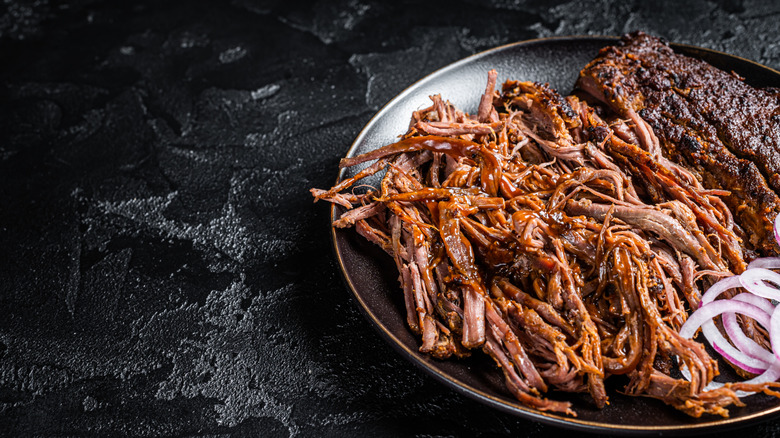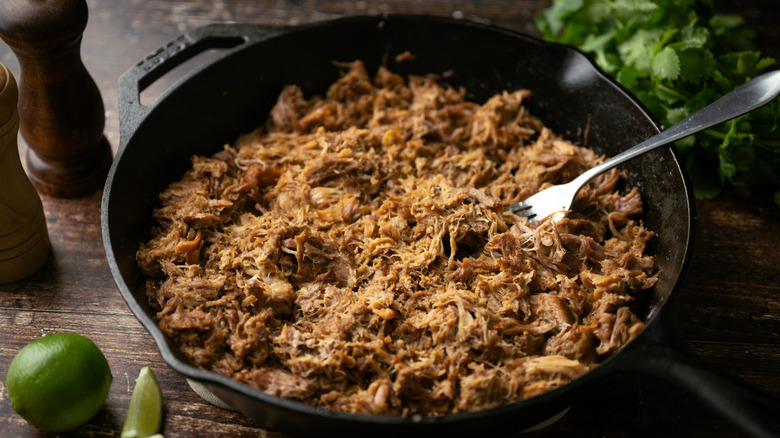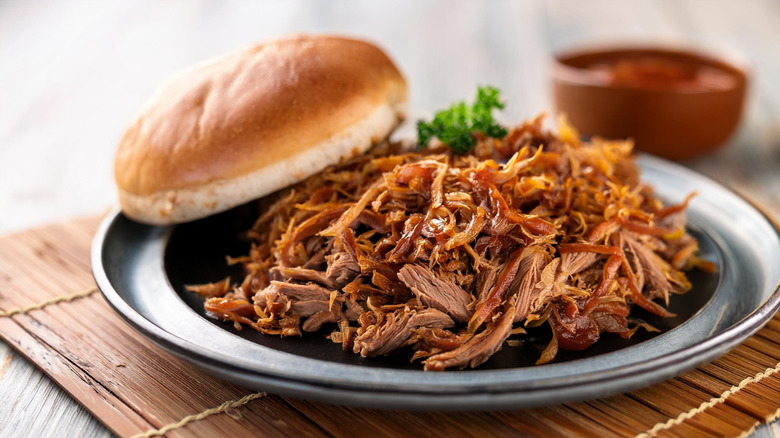Carnitas Vs Pulled Pork: What's The Difference?
It's hard to go wrong with pork; the protein shines in many forms. However, there's a special magic to it when the meat is patiently cooked on low heat, especially when utilizing larger cuts like the pork shoulder. A mouth-watering juiciness emerges, by way of the fat and connective tissue melting into the cut. In North America, you most commonly find such a cooking method showcased in carnitas and pulled pork. The former hails from Mexico — specifically the town of Quiroga in the state of Michoacán — and usually appears in a taco. The latter is a Southern barbecue classic, often coming in sandwich form with a tangy, smoky sauce to accompany.
Other than how they're usually served, you may have wondered what distinguishes the two meat styles. After all, they're both composed of small pieces of juicy, flavorful pork cooked low and slow. Turns out, there are nuances to the two regional dishes with traditional cooking techniques and flavors. To best understand the full range of their porky goodness, it's helpful to dive into the details.
What are carnitas?
Translating to "little meats" from Spanish, carnitas call for slow-cooking large cuts such as ham, pork shoulder, or pork butt. Contained in a large copper pot known as a cazo, legs, ribs, and other pig parts may also end up in the mix. However, carnitas aren't defined by the part of the pig used but by the process of slow-cooking the meat in lard, making it a form of confit. The aim is to attain a moist interior and crispy edges, all with an attractive, fat-induced sparkle.
Carnitas include many seasonings, with every chef creating their own spin. Common spice mixes contain cumin, oregano, onions, garlic, limes, and chilies, though other herbs, fruit, Coca-Cola, and even milk products may be introduced. Prepared properly, the dish has a slight sweetness and deep richness. Typically, the pork dish is served as do-it-yourself tacos, accompanied with a spicy salsa and pickled vegetables. However, it's also used as a filling in enchiladas, tortas, burritos, and other Mexican dishes.
What is pulled pork?
Head to any barbecue restaurant across the Southern United States and you'll find many regional renditions of pulled pork. That said, pulled pork recipes typically reach for the shoulder, which lends a delicious, juicy result thanks to fat marbling. As a part of the barbecue canon, smoking is often the go-to preparation technique. However, it doesn't define the style — the oven, pressure cooker, and slow cooker easily make great pulled pork. What's key is time: The meat requires hours of low-and-slow heating in order to render the intrinsic fat. With enough patience, a large, multi-pound cut of pork turns into shredded pieces of meat that are often pulled apart by forks, hence the name.
The meat can be seasoned before or after cooking with most chefs employing their own spice rub. Regionally interlinked with a barbecue style, common options include cumin, chili powder, dry mustard, paprika, onion powder, garlic powder, and brown sugar. However, recipes vary in emphasis on sweet, peppery, or herbal notes. Plus, there's always an amazing homemade barbecue sauce to add more flavor. Such is the appeal of the dish; it's a forgiving, yet delicious canvas of pork flavor.


